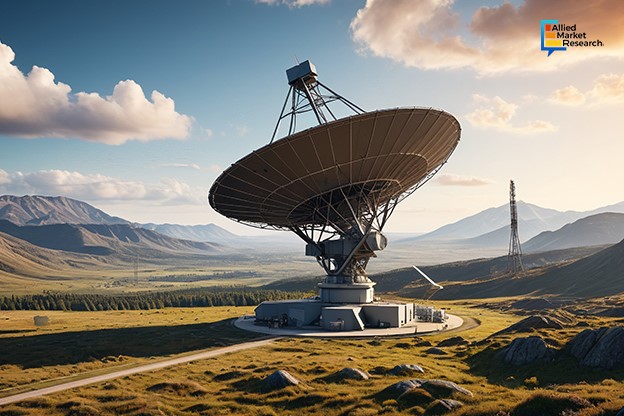Understanding the Role of Satellite Ground Stations in Modern Telecommunications

30 Apr
2025
Key takeaways:
- Introduction
- Latest developments in the industry
- Strategic alliances among the companies
Satellite ground stations (SGS) are terrestrial radio systems that transmit and receive satellite data. The collected data is then analyzed and passed on to different users and applications based on their functionalities. For example, one of the main uses of SGSs is to gather meteorological information and provide it to governmental agencies for framing agricultural policies and managing disaster relief operations. Similarly, military satellite ground stations help armies to compile data on enemy troop movements, conduct reconnaissance missions, and strategize their future course of action accordingly. Also called Earth stations, these radio systems are now widely used in various end-use industries of the global economy. Moreover, the rise in adoption of different digital tools and the growing demand for online streaming services have impacted the sector positively in recent times.
Innovations in terrestrial radio systems boosting the revenue of the industry
The satellite ground station industry accounted for $58.7 billion in 2022 and is predicted to gather a revenue share of $178.9 billion by 2032, rising at a CAGR of 11.9% during 2023-2032. Technological advancements and innovations in telecommunications have played an important role in the expansion of the sector in the past few years. Earlier, space exploration and extraplanetary communication were open solely for governmental agencies. However, in the last decades, several countries have started allowing private companies to operate in this field and establish their satellite ground stations. State-owned organizations like NASA have even partnered with commercial providers to launch and manage satellite communication services, thus broadening the scope of the industry.
Along with this, the use of phase-array antennas has opened new investment avenues in the industry. Conventional radio transmitters and receivers feature mechanical antennas that require physical movement to scan for different targets, thus making it difficult for operators to collect data from multiple sources. On the contrary, phased-array antennas are designed to electronically steer their beams as per the target’s location. Hence, these solutions become ideal to communicate with moving satellite devices. Also, these systems have multi-beam capabilities, which help them collect information from several extraplanetary devices seamlessly.
M&A deals among leading players generating new growth opportunities
Over the years, the satellite ground station market has experienced significant growth owing to the strategic alliances established by key businesses in the sector. In April 2024, Space Leasing International (SLI), a space infrastructure leasing company, announced the acquisition of a satellite ground station in Piteå, Sweden. The press release issued by Space Leasing International (SLI) stated that this newly acquired Earth station was leased to RBC Signals, a ground station as a service (GSaaS) firm. The deal signed between the two companies is expected to help both companies increase their footprint globally in the coming period.
Similarly, in August 2024, EQT AB, a private equity company, announced that it had entered into talks with Eutelsat Group, a telecommunications enterprise, to acquire its satellite ground station infrastructure business. Eutelsat Group has been one of the most promising players in the industry and owns more than 1,400 antennas at over 100 locations across the globe. The press statement issued by EQT highlighted that the company is keen on acquiring around 80% of the stake in the company for a value of EUR 790 million.
In summary, the growth of the satellite ground station industry is attributed to the rising need for digital communications across the world. Furthermore, recent advancements in antenna technology and the surge in public-private partnerships in the space sector are predicted to strengthen the position of the market in the coming period.
Contact our experts for tips and recommendations on how to capitalize on the opportunities offered by the industry!

Akhilesh Prabhugaonkar
Author's Bio- Akhilesh Prabhugaonkar holds a bachelor’s degree in Electronics Engineering from the reputed Vishwakarma Institute of Technology. He has a special interest in the fields of forensics, world history, international relations and foreign policy, sports, agriculture, astronomy, security, and oceanography. An ardent bibliophile and melophile, Akhilesh loves to write on topics of his interest and various other societal issues. This love for writing made him enter the professional world of content writing and pursue his career in this direction.
Aerospace Parts Manufacturing: Introduction of 3D Printing and AI Transforming the Industry
Avenue: Entire Library membership of Allied Market Research Reports at your disposal
- Avenue is an innovative subscription-based online report database.
- Avail an online access to the entire library of syndicated reports on more than 2,000 niche industries and company profiles on more than 12,000 firms across 11 domains.
- A cost-effective model tailored for entrepreneurs, investors, and students & researchers at universities.
- Request customizations, suggest new reports, and avail analyst support as per your requirements.
- Get an access to the library of reports at any time from any device and anywhere.
Related Post
-
How are Submarine Cables Transforming Global Connectivity with Enhanced User Experience?
-
Endoscopy Procedures: Transformations in Techniques and Applications
-
AI-Powered Video Analytics: How the Product Actually Works for enterprises
-
Painting Robots: Transforming Precision Coating and Creative Applications
-
Innovations in Pharmacovigilance Systems Advancing Patient Safety
-
Understanding Edge Security: Keeping Data Safe Near the Source
-
Exploring the Use and Advancements of 3D Laser Scanners in Professional Applications
-
Reinforcing Industrial Controls with Smarter Tools and Training








